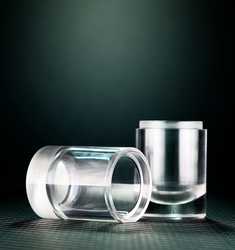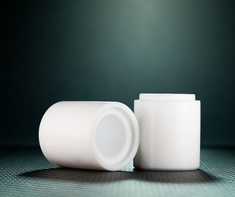PLASTIC MiLLIng vessels

POLYMETHYL METACRYLATE (PMMA or PLEXIGLAS)
Due to its transparency, strength and great mechanic properties, PMMA is the polymer of choice for various applications, ranging from displays to shields for motorcycles or boats. In mechanochemistry, PMMA vessels were used for developing the in situ monitoring XRD[1] and Raman techniques,[2] which revolutionized the field and provided unprecedented insight into mechanochemical reactivity.
These vessels are cheap, resistant to acids, alcohols and some hydrocarbons. They will allow you to visually monitor your reaction even without advanced monitoring equipment.
[1] Friščić et al, Real-time and in situ monitoring of mechanochemical milling reactions, Nature Chemistry, 2013, 5, 66.
[2] Gracin et al, Laboratory Real-Time and In Situ Monitoring of Mechanochemical Milling Reactions by Raman Spectroscopy, Angew. Chem. Int. Ed. 2014, 53, 61.
Due to its transparency, strength and great mechanic properties, PMMA is the polymer of choice for various applications, ranging from displays to shields for motorcycles or boats. In mechanochemistry, PMMA vessels were used for developing the in situ monitoring XRD[1] and Raman techniques,[2] which revolutionized the field and provided unprecedented insight into mechanochemical reactivity.
These vessels are cheap, resistant to acids, alcohols and some hydrocarbons. They will allow you to visually monitor your reaction even without advanced monitoring equipment.
[1] Friščić et al, Real-time and in situ monitoring of mechanochemical milling reactions, Nature Chemistry, 2013, 5, 66.
[2] Gracin et al, Laboratory Real-Time and In Situ Monitoring of Mechanochemical Milling Reactions by Raman Spectroscopy, Angew. Chem. Int. Ed. 2014, 53, 61.

PTFE (TEFLON)
Polytetrafluoroethylene, PTFE, is one of the most resistant polymers to acids, bases or organic solvents, making it a material of choice for a majority of chemicals reactors. In mechanochemistry, it is considered to be ideal for milling reactions requiring totally inert vessel, such as the preparation of active pharmaceutical ingredients or the syntheses requiring strong acids or bases.
Polytetrafluoroethylene, PTFE, is one of the most resistant polymers to acids, bases or organic solvents, making it a material of choice for a majority of chemicals reactors. In mechanochemistry, it is considered to be ideal for milling reactions requiring totally inert vessel, such as the preparation of active pharmaceutical ingredients or the syntheses requiring strong acids or bases.

POLYAMIDE
With a good chemical resistance and toughness , polyamide is often used for various outdoor applications. Due to its hardness, milling vessels made of polyamide will provide high-energy impact in the milling, while ensuring a weight/durability ratio unprecedented in other plastic materials.
With a good chemical resistance and toughness , polyamide is often used for various outdoor applications. Due to its hardness, milling vessels made of polyamide will provide high-energy impact in the milling, while ensuring a weight/durability ratio unprecedented in other plastic materials.